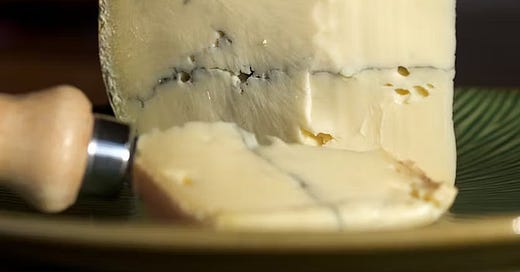image via Bustle.com
When my chemist collaborator Joseph DiVerdi and I first set out to study aroma differences across cannabis strains, we had to assemble a list of odor descriptors for our sensory panelists to use. As a first take, I scoured online weed sites to collect adjectives from “smoke reports” and strain reviews. After eliminating synonyms and non-olfactory terms (mellow, harsh, etc.), we still had to strike a balance between higher-order (berry) and specific identifiers (blueberry, strawberry).
Tougher decisions involved an odd (to me) set of dairy-related terms: butter, cheese, and blue cheese. Could cannabis really smell like this? We decided to include these terms—after all, this was an exploratory study and it would be informative to learn whether or not they were useful.
Our results—the first study to use sensory panelists to assess cannabis aroma—were published in PLoS ONE. Among other things, we found that butter, cheese, and blue cheese were indeed useful descriptors for weed. This reinforced my hunch that the conventional wisdom about cannabis smell was wrong. It’s not “all about terpenes.” Sure, terpenes constitute the bulk of the volatile molecules in weed, but they aren’t the whole story. One simply can’t get to cheese (or skunky or diesel) with terpenes alone.
In a recent series of papers, the R&D team at Abstrax Tech* in California have nailed down the elusive molecules behind some of these weird, but characteristic, non-terpene notes. By fine-tuning their analytic instruments and using data from sensory panelists, the Abstrax crew identified a set of sulfur-containing molecules as the source of the skunky, gas, and diesel odors. (I wrote about their discovery here.)
While present at very low concentrations, these sulfur compounds nevertheless pack a large olfactory punch.
Next, the Abstrax team identified a number of molecules behind the “exotic” tropical fruit impressions (pineapple, mango, etc.) typical of certain strains.
So what about the cheese notes detected by our sensory panelists? Once again, the Abstrax team has delivered the goods: cheese notes are produced by the presence of octanoic acid and decanoic acid (neither one a terpene).
As it happens, decanoic acid is commonly used in the flavor and fragrance industry. According to flavorist John Wright, this “distinctly cheesy” molecule straddles the divide between aroma and taste, and is a critical component of dairy flavors like butter, blue cheese, and cheddar. It is useful in lesser concentrations in milk, cream, and yogurt formulations. Wright points out that decanoic acid is “an important part of all fermented flavors,” including beer, brandy, rum, whiskey, and wine. It also has a role in savory (bacon, roast beef) and even in some fruit flavors such as apple and blue berry. In the latter, it provides a background taste effect “associated with the skin profile.” Finally, decanoic acid “is a vital contributor to all coconut flavors.”
*Full disclosure: Abstrax Tech is a client of mine and I am also a member of their Scientific Advisory Board. Their sensory and analytic chemistry teams are top notch, as evidenced by their string of ground-breaking scientific publications.
Avery N. Gilbert and Joseph A. DiVerdi, Consumer perceptions of strain differences in Cannabis aroma. PLoS ONE 13:e0192247, 2018.
Iain W. H. Oswald, Marcos A. Ojeda, Ryan J. Pobanz, Kevin A. Koby, Anthony J. Buchanan, Josh Del Rosso, Mario A. Guzman, and Thomas J. Martin, Identification of a new family of prenylated volatile sulfur compounds in Cannabis revealed by comprehensive two-dimensional gas chromatography. ACS Omega 6:31667-31676, 2021.
Iain W. H. Oswald, Twinkle R. Paryani, Manuel E. Sosa, Marcos A. Ojeda, Mark R. Altenbernd, Jonathan J. Grandy, Nathan S. Shafer, Kim Ngo, Jack R. Peat III, Bradley G. Melshenker, Ian Skelly, Kevin A. Koby, Michael F. Z. Page, and Thomas J. Martin, Minor, nonterpenoid volatile compounds drive the aroma differences of exotic Cannabis. ACS Omega 8:39203-39216, 2023.
Twinkle R. Paryani, Manuel E. Sosa, Michael F. Z. Page, Thomas J. Martin, Melissa V. Hearvy, Marcos A. Ojeda, Kevin A. Koby, Jonathan J. Grandy, Bradley G. Melshenker, Ian Skelly, and Iain W. H. Oswald. Nonterpenoid chemical diversity of cannabis phenotypes predicts differentiated aroma characteristics. ACS Omega 9:28806-28815, 2024.
John Wright. Flavor bites: Decanoic acid. Perfumer & Flavorist 48:20-22, 2023.




